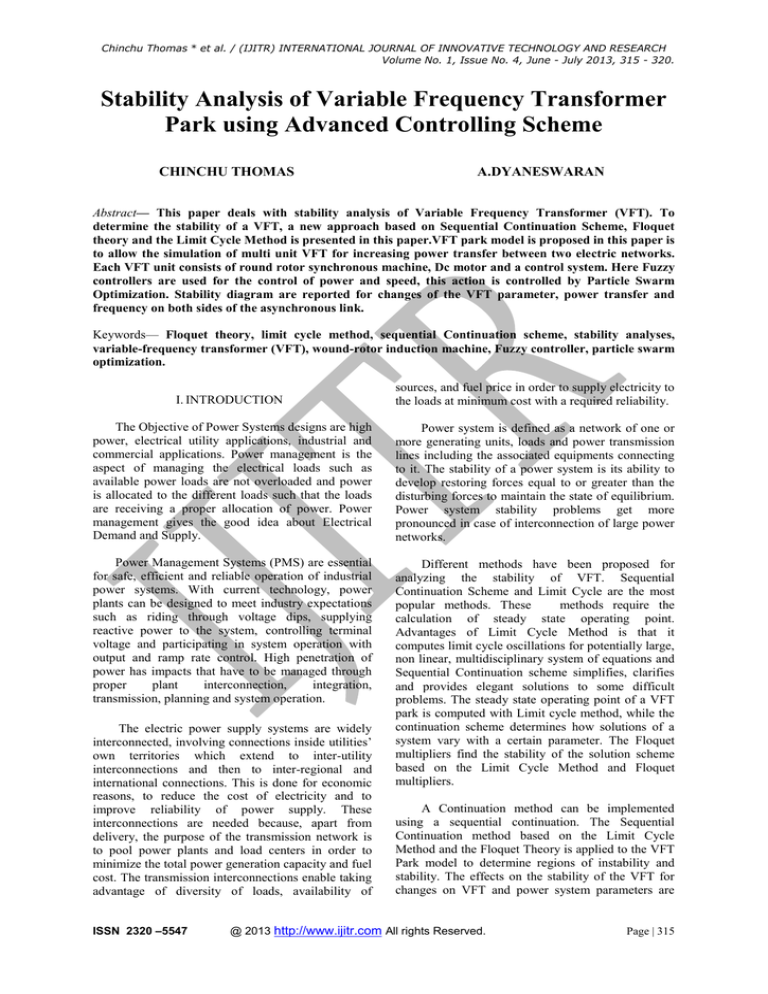
Chinchu Thomas * et al. / (IJITR) INTERNATIONAL JOURNAL OF INNOVATIVE TECHNOLOGY AND RESEARCH
Volume No. 1, Issue No. 4, June - July 2013, 315 - 320.
Stability Analysis of Variable Frequency Transformer
Park using Advanced Controlling Scheme
CHINCHU THOMAS
A.DYANESWARAN
Abstract— This paper deals with stability analysis of Variable Frequency Transformer (VFT). To
determine the stability of a VFT, a new approach based on Sequential Continuation Scheme, Floquet
theory and the Limit Cycle Method is presented in this paper.VFT park model is proposed in this paper is
to allow the simulation of multi unit VFT for increasing power transfer between two electric networks.
Each VFT unit consists of round rotor synchronous machine, Dc motor and a control system. Here Fuzzy
controllers are used for the control of power and speed, this action is controlled by Particle Swarm
Optimization. Stability diagram are reported for changes of the VFT parameter, power transfer and
frequency on both sides of the asynchronous link.
Keywords— Floquet theory, limit cycle method, sequential Continuation scheme, stability analyses,
variable-frequency transformer (VFT), wound-rotor induction machine, Fuzzy controller, particle swarm
optimization.
I. INTRODUCTION
sources, and fuel price in order to supply electricity to
the loads at minimum cost with a required reliability.
The Objective of Power Systems designs are high
power, electrical utility applications, industrial and
commercial applications. Power management is the
aspect of managing the electrical loads such as
available power loads are not overloaded and power
is allocated to the different loads such that the loads
are receiving a proper allocation of power. Power
management gives the good idea about Electrical
Demand and Supply.
Power system is defined as a network of one or
more generating units, loads and power transmission
lines including the associated equipments connecting
to it. The stability of a power system is its ability to
develop restoring forces equal to or greater than the
disturbing forces to maintain the state of equilibrium.
Power system stability problems get more
pronounced in case of interconnection of large power
networks.
Power Management Systems (PMS) are essential
for safe, efficient and reliable operation of industrial
power systems. With current technology, power
plants can be designed to meet industry expectations
such as riding through voltage dips, supplying
reactive power to the system, controlling terminal
voltage and participating in system operation with
output and ramp rate control. High penetration of
power has impacts that have to be managed through
proper
plant
interconnection,
integration,
transmission, planning and system operation.
Different methods have been proposed for
analyzing the stability of VFT. Sequential
Continuation Scheme and Limit Cycle are the most
popular methods. These
methods require the
calculation of steady state operating point.
Advantages of Limit Cycle Method is that it
computes limit cycle oscillations for potentially large,
non linear, multidisciplinary system of equations and
Sequential Continuation scheme simplifies, clarifies
and provides elegant solutions to some difficult
problems. The steady state operating point of a VFT
park is computed with Limit cycle method, while the
continuation scheme determines how solutions of a
system vary with a certain parameter. The Floquet
multipliers find the stability of the solution scheme
based on the Limit Cycle Method and Floquet
multipliers.
The electric power supply systems are widely
interconnected, involving connections inside utilities’
own territories which extend to inter-utility
interconnections and then to inter-regional and
international connections. This is done for economic
reasons, to reduce the cost of electricity and to
improve reliability of power supply. These
interconnections are needed because, apart from
delivery, the purpose of the transmission network is
to pool power plants and load centers in order to
minimize the total power generation capacity and fuel
cost. The transmission interconnections enable taking
advantage of diversity of loads, availability of
ISSN 2320 –5547
A Continuation method can be implemented
using a sequential continuation. The Sequential
Continuation method based on the Limit Cycle
Method and the Floquet Theory is applied to the VFT
Park model to determine regions of instability and
stability. The effects on the stability of the VFT for
changes on VFT and power system parameters are
@ 2013 http://www.ijitr.com All rights Reserved.
Page | 315
Chinchu Thomas * et al. / (IJITR) INTERNATIONAL JOURNAL OF INNOVATIVE TECHNOLOGY AND RESEARCH
Volume No. 1, Issue No. 4, June - July 2013, 315 - 320.
presented. The continuation parameters chosen in this
work is the VFT power transfer. This method makes
use of PSO based Fuzzy controller in the VFT control
system for efficient power transfer between the
asynchronous networks. The computation of the
stability regions of the VFT control system provides
the system designer with valuable information for
tuning the Fuzzy controller.
orients itself to follow the phase angle difference
imposed by the two asynchronous systems.
II VFT PARK MODEL
Fig.1 shows the configuration of the VFT Park
proposed in this work for power exchange between
two asynchronous power grids. This scheme consists
of VFT units connected in parallel, where each unit is
modeled with a WRIM, a dc motor, coupling
transformers, capacitor banks, and a control system.
The control system consists of power and speed
regulators to adjust the mechanic torque drive. The
VFT is essentially a continuously adjustable phase
shifting transformer that can be operated at an
adjustable phase angle. The VFT consists of
following core components: a rotary transformer for
power exchange, a drive motor
to control the
movement or speed of the rotor and to control the
transfer of power. A drive motor is used to apply
torque to the rotor of the rotary transformer and
adjust the position of the rotor relative to the stator,
thereby controlling the magnitude and direction of the
power transmission through the VFT.
A stable power exchange between the two
asynchronous systems is possible by controlling the
speed and torque applied to the rotor, which are
controlled externally by the drive motor. When the
systems are in synchronism, the rotor of VFT remains
in the position in which the stator and rotor voltage
are in phase with the associated systems. In order to
transfer power from one system to other, the rotor of
the VFT is rotated. If torque applied is in one
direction, then power transmission takes place from
the stator winding to the rotor winding. If torque is
applied in the opposite direction, the power
transmission takes place from the rotor winding to
stator winding. The power transmission is
proportional to the
magnitude and direction of the torque applied. The
drive motor is designed to continuously produce
torque even at zero speed.
When the two systems are no longer in
synchronism, the rotor of the VFT will rotate
continuously and the rotational speed will be
proportional to the difference in frequency between
the two power networks. During this operation the
power transmission or flow is maintained. The VFT
is designed to continuously regulate power
transmission even with drifting frequencies on both
grids. Regardless of power transmission, the rotor
ISSN 2320 –5547
Fig.1. VFT Park simplified diagram consisting of
multiunit VFTs
A closed loop power regulator compares the
measured power with the set point and adjusts motor
torque The VFT is designed to continuously regulate
power transmission even with drifting frequencies on
both grids. Regardless of power transmission, the
rotor orients itself to follow the phase angle
difference imposed by the two asynchronous systems.
III.VFT CONTROL SYSTEM
The VFT Park control system determines the
number of VFT units required to reach the desired
power transfer capacity. Control system of VFT
consists of reactive Power Compensator, Power
Regulator, Speed Regulator and Comparator.
Fig.2. VFT control system including power speed
regulators.
Fig. 2 illustrates an elementary control system for
one VFT unit, which provides power regulation by
adjusting the rotor speed It compares the power
@ 2013 http://www.ijitr.com All rights Reserved.
Page | 316
Chinchu Thomas * et al. / (IJITR) INTERNATIONAL JOURNAL OF INNOVATIVE TECHNOLOGY AND RESEARCH
Volume No. 1, Issue No. 4, June - July 2013, 315 - 320.
capacity of VFT with the power transfer demanded
and assigns a rated power transfer command. Then,
each VFT unit control system receives a control
signal in order to contribute with a specific control
flow. Reactive power compensation is provided on
both sides of the VFT installation in order to alleviate
the reactive power demand of each VFT unit. It
consists of shunt capacitor banks, switched as a
function of the VFT power transfer.. The power
regulator shown in Fig.2 measures the power flow
throughout the VFT and compares it with its
reference power. The error signal is fed to a Fuzzy
controller and its output represents a speed command.
A reference for the mechanic torque is obtained, by
comparing the rotor speed and the speed command
determined by the power regulator. A Fuzzy
controller computes the torque command using the
speed error signal of the speed regulator and a torque
limiter prevents the torque command to be within the
dc motor
IV LIMIT CYCLE METHOD
An electric system can be described as,
= f (t,x), x (t0) = x0
(1)
Where X is a m-dimensional state vector and Xo is
the initial condition. If the set of Ordinary differential
Equations as a periodic driving force so that f(t,.) is
also T-periodic, then it can be represented as a limit
cycle for X∞ in terms of an arbitrary T-periodical
function.
Assuming a single transient orbit that starts at xi
and ends at xi+1 after one cycle of integration, its
dynamic behavior is described by its intercepts on the
Poincare map, ∑ (see fig.3). The transformation of
problem into a variation problem as the form
∆ =J(t) ∆
(2)
And the general solution matrix that calculates ∆X is,
∆X(T)= (T)∆X(0)
(3)
Where and J are the transition and Jacobian matrix,
respectively.
The solution of the state variables at the limit cycle is
computed
X∞=X0+(I- )-1 (Xꞌ0-X0)
(4)
Where, X∞ state variables at the limit cycle,
X0 state variables at the beginning of the base cycle
Xꞌ0 state variables ate end of the base cycle
Limit Cycle Method by computing the transition
matrix and the state variables at the limit cycle X α.
The predicted value is corrected through the limit
cycle method. Floquet multipliers are computed with
the transition matrix identified with the limit cycle
method. The predicted value Xi is corrected with the
Limit Cycle method.
ISSN 2320 –5547
Fig.3.Single Transient orbit on the poincare map
A. Floquet Multipliers
Once the steady-state is determined, Floquet
multipliers can be computed using transition matrix.
This process is repeated for each grid point αi for
i=1,2….,u. . In this paper, the periodic solution
computed in the previous step is used as an initial
guess for the periodic solution to be determined in the
next step. Finally, Floquet multipliers are plotted to
obtain the stability diagram.
V. SEQUENTIAL CONTINUATION SCHEME
A continuation scheme relies on the variation of the
solutions =f(t,x), x(t0)=x0
(5)
defined as
f (t,x,α) = 0
Where α € M is the continuation parameter and M is
a parameter vector. The parameter α varies within an
interval, which is divided into an equally spaced grid
points α0, α1, α2. The solution Xi at αi used as the
predicted value for the solution Xi+1 at αi+1. This
predicted value is usually corrected through a
Newton–Raphson scheme.
The continuation method applies a sequential
and predictor-corrector scheme. The general structure
of the continuation scheme based on the limit cycle
method consists of major steps, such as a
parameterization strategy and a predictor-corrector
scheme. It can be appreciated that as a first step, an
initial steady-state solution X0 is assumed for an
initial scalar parameter α0 and the initial predicted
value is set with Xi = Xα = X0 at αi = α0. .
The stability of a steady-state solution can be
studied using continuation schemes and Floquet
multipliers. While the continuation scheme
determines how solutions of a system vary with a
certain parameter, Floquet multipliers find the
stability of the solutions. A continuation method can
@ 2013 http://www.ijitr.com All rights Reserved.
Page | 317
Chinchu Thomas * et al. / (IJITR) INTERNATIONAL JOURNAL OF INNOVATIVE TECHNOLOGY AND RESEARCH
Volume No. 1, Issue No. 4, June - July 2013, 315 - 320.
be implemented using a sequential continuation or a
Newton-Raphson approach.
positions in the search-space, which are updated as
better positions are found by other particles. This is
expected to move the swarm toward the best
solutions.
Fig.4 Flowchart of Sequential Continuation
Scheme
The averaging methods can be useful for
computing the steady-state and performing stability
analysis by setting to zero and linearizing the
averaged model, respectively. Average modeling
decreases simulation time and suppresses some fast
time constants compared to a conventional simulation
tool. However, the modeling complexity increases
with the number of switches and the nature of the
operating mode.Recently, the concept of dynamic
phasor based on a generalized averaging procedure
has been put forward to determine approximate
nonlinear models. This proposal offers a good
compromise between accuracy and computational
effort for a benchmark power system test case
consisting of a three-phase synchronous generator.
However, the size of the resulting dynamic phasor
model is proportional to the number of retained
harmonics.
VI. PARTICLE SWARM OPTIMIZATION
This paper integrates PSO approach for
analyzing stability of VFT. PSO is a computational
method that optimizes a problem by iteratively trying
to improve a candidate solution with regard to a given
measure of quality.
PSO optimizes a problem by having a population of
candidate solutions, here dubbed particles, and
moving these particles around in the search-space
according to simple mathematical formula over the
particle's position and velocity.
Each
particle's
movement is influenced by its local best known
position and is also guided toward the best known
ISSN 2320 –5547
Fig.5.Flowcart of particle Swarm Optimization
PSO shares many similarities with evolutionary
computation techniques such as Genetic Algorithms
(GA). The system is initialized with a population of
random solutions and searches for optima by
updating generations. However, unlike GA, PSO has
no evolution operators such as crossover and
mutation. In PSO, the potential solutions, called
particles, fly through the problem space by following
the current optimum particles.
VII. FUZ ZY CONTROLLER
Controlling is an important function because it
helps to check the errors and to take the corrective
action so that deviation from standards are minimized
and stated goals of the organization are achieved in a
desired manner. A fuzzy control system is a control
system based on fuzzy logic—a mathematical system
that analyzes analog input values in terms of logical
variables that take on continuous values between 0
and 1. Fuzzy control system design is based on
empirical methods, basically a methodical approach
to trial-and-error. The general process is as follows:
Document
the
system's
operational
specifications and inputs and outputs.
Document the fuzzy sets for the inputs.
Document the rule set.
Determine the defuzzification method.
Run through test suite to validate system,
@ 2013 http://www.ijitr.com All rights Reserved.
Page | 318
Chinchu Thomas * et al. / (IJITR) INTERNATIONAL JOURNAL OF INNOVATIVE TECHNOLOGY AND RESEARCH
Volume No. 1, Issue No. 4, June - July 2013, 315 - 320.
adjust details as required.
Complete document and
production.
Building a fuzzy controller.
release
to
where as a decrease in rotor resistance results in an
increase in the region of instability.
Fig.6. Fuzzy Control Design
Fuzzy controllers are improved version when
compared to both PI and PID controller, capable of
extracting maximum power and can provide fast
control actions in comparison to conventional
controllers.
VIII. SIMULATION STUDIES
In this paper PSO based Fuzzy controller is used
in control system of VFT. The stability analysis is
done using Sequential Continuation Scheme and
Limit Cycle Method. Nonstable regions have been
identified for changes of frequency of the
asynchronous networks and power transfer. Sustained
oscillations on the VFT power transfer have been
observed when the VFT Park operates in the
nonstable region. Instability is very likely to occur in
VFTs if the rotor circuit is connected to a weak power
network showing variations of frequency. Based on
the simulation results, it is recommended to connect
the rotor side of the VFT to the power system that
shows minor frequency variations.
Figure.7. Stability regions for changes of rotor
resistance
The figure 7 shows the effect on the instability
region when varying the rotor resistance. An increase
of rotor resistance from the nominal value rr= 0.001
to rr= 0.003 p.u. produces an increase of the stability
region and reduces the non stable region. Therefore
an increase in rotor resistance tends to promote VFT
stability within the power margin PVFT=
p.u.,
ISSN 2320 –5547
Fig.8. Stability regions of changes of
magnetizing reactance
Figure 8 shows the effect on the instability region
when varying magnetizing reactance. A decrease in
magnetizing reactance tends to decrease the regions
of instability. A small magnetizing reactance results
in the disappearance of the instability region.
Fig.9. Transient solution during changes in power
transfer reference for (a) active power, (b) reactive
power and (c) rotor angle
When VFT operates with PVFT =1.0 p.u, fs=60 z
and fr=58 z, it is said to be the steady state operation
of VFT. The sudden power transfer to PVFT=-1.0 p.u
corresponds to a change from a stable operating point
to a non stable point of operation. Sustained
oscillations will occur in the power and angle of VFT.
When the reference power transfer is switched to PVFT
=0 p.u, control system determines an operating point
within the stable region.
IX.CONCLUSION
This project has proposed a new method for
analyzing the stability of VFT, also finds high quality
solution. It is recognized that the use of PSO based
Fuzzy controller in the VFT control system has
resulted in efficient power transfer between the
asynchronous networks. Here Limit Cycle Method
computes limit cycle oscillations for potentially large,
@ 2013 http://www.ijitr.com All rights Reserved.
Page | 319
Chinchu Thomas * et al. / (IJITR) INTERNATIONAL JOURNAL OF INNOVATIVE TECHNOLOGY AND RESEARCH
Volume No. 1, Issue No. 4, June - July 2013, 315 - 320.
non linear, multidisciplinary system of equations.
Sequential Continuation scheme simplifies, clarifies
and provides elegant solutions to some difficult
problems. VFT technology provides an option for
achieving real power transmission or power flow
control in-between two or more power systems. The
computation of the stability regions of the VFT
control system provides the system designer with
valuable information for tuning the Fuzzy controller
[10]
[11]
REFERENCES
[1]
[2]
[3]
[4]
[5]
[6]
[7]
[8]
[9]
D. Mc Nabb, D. Nadeau, A. Nantel, E. Pratico,
E. Larsen, G. Sybille, V. Q. Do, and D. Paré,
“Transient and dynamic modeling of the new
langlois VFT asynchronous tie and validation
with commissioning tests,” in Proc. Int. Conf.
Power Systems Transients, Canada, Jun. 2005,
pp. 1–6.
G. Chen and X. Zhou, “Digital simulation of
variable
frequency
transformers
for
asynchronous interconnection in power
system,” in Proc. IEEE Power Eng. Soc.
Transmission and Distribution Conf., Dalian,
China, Dec. 2005, pp. 1–6.
E. R. Pratico, C.Wegner, E. V. Larsen, R. J.
Piwko, D. R.Wallace, and D. Kidd, “VFT
operational overview—The laredo project,” in
Proc. IEEE Power Eng. Soc. Gen. Meeting,
FL, Jul. 2007, pp. 1–6.
A. Merkhouf, P. Doyon, and S. Upadhyay,
“Variable frequency transformer— Concept
and electromagnetic design evaluation,” IEEE
Trans. Energy Convers., vol. 23, no. 4, pp.
989–996, Dec. 1992.
J. J. Marczewski, “VFT Applications Between
Grid Control Areas,” IEEE PES General
Meeting, Tampa, FL, June 2007, pp. 1-4.
E. Larsen, R. Piwko, D. McLaren, D.
McNabb, M. Granger, M. Dusseault, L-P.
Rollin, J. Primeau, "Variable Frequency
Transformer - A New Alternative for
Asynchronous Power Transfer," Canada
Power, Toronto, Ontario, Canada, September
28-30,2004.
P. Doyon, D. McLaren, M. White, Y .Li, P.
Truman, E. Larsen, C. Wegner, E. Pratico, R.
Piwko, "Development of a 100 MW Variable
Frequency Transformer," Canada Power,
Toronto, Ontario, Canada, September 28-30,
2004.
M. Dusseault, J. M. Gagnon, D. Galibois, M.
Granger, D. McNabb, D. Nadeau, J. Primeau,
S. Fiset, E. Larsen, G. Drobniak, I. McIntyre,
E. Pratico, C. Wegner, "First VFT Application
and Commissioning," Canada Power,
Toronto, Ontario, CANADA, September 2830, 2004.
R. D. Middlebrook and S. Cuk, “A general
unified approach to modeling switching power
ISSN 2320 –5547
[12]
[13]
[14]
[15]
[16]
[17]
[18]
[19]
[20]
[21]
[22]
converter stages,” Proc. IEEE Power Eng.
Soc. Conf. Rec., pp. 18–34, 1976.
S. R. Sanders, J. M. Noworolski, X. Z. Liu,
and G. C. Verghese, “Generalized averaging
method for power conversion circuits,” IEEE
Trans. Power Electron., vol. 6, no. 2, pp. 251–
259, Apr. 1991.
V. A. Caliskan, G. C. Verghese, and A. M.
Stankovic, “Multifrequency averaging of
DC/DC converters,” IEEE Trans. Power
Electron., vol. 14, no. 1, pp. 124–133, Jan.
1999.
A. M. Stankovic and T. Aydin, “Analysis of
asymmetrical faults in power systems using
dynamic phasors,” IEEE Trans. Power Syst.,
vol. 15, no. 3, pp. 1062–1068, Aug. 2000.
K. Astrom and T. Hagglund, PID Controllers:
Theory, Design andTuning, 2nd ed. Research
Triangle Park, NC: Instrum. Soc. Amer., 1995.
Arezki Merkhouf, Pierre Doyon and Sanjoy
Upadhyay,
“Variable
Frequency
Transformer—Concept and Electromagnetic
Design Evaluation,” IEEE Transactions on
Energy Conversion, vol. 23, no. 4, December
2008, pp. 989-996.
P. Kundur, Power System Stability and
Control. New York: McGraw- Hill, 1994.
T. S. Parker and L. O. Chua, Practical
Numerical Algorithms for Chaotic Systems.
New York: Springer-Verlag, 1989.
A. Semlyen and A. Medina, “Computation of
the periodic steady state in systems with
nonlinear components using a hybrid time and
frequency domain methodology,” IEEE Trans.
Power Syst., vol. 10, no. 3, pp. 1489–1504,
Aug. 1995.
A. H. Nayfeh and B. Balachandran, Applied
Nonlinear
Dynamics:
Analytical,
Computational and Experimental Methods.
NewYork:Wiley, 1995.
V. Ajjarapu and B. Lee, “Bifurcation theory
and its application to nonlinear dynamical
phenomena in an electrical power system,”
IEEE Trans. Power Syst., vol. 7, no. 1, pp.
424–431, Feb. 1992.
C. Kieny, “Application of the bifurcation
theory in studying and understanding the
global behavior of a ferroresonant electric
power circuit,” IEEE Trans. Power Del., vol.
6, no. 2, pp. 866–872, Apr. 1991.
C. Kieny, G. Le Roy, and A. Sbai,
“Ferroresonance study using galerkin method
with pseudo-arclength continuation method,”
IEEE Trans. Power Del., vol. 6, no. 4, pp.
1841–1847, Oct. 1991.
S. R. Naidu and B. A. Souza, “Analysis of
ferroresonant circuits using a NewtonRaphson scheme,” IEEE Trans. Power Del.,
vol. 12, no. 4, pp. 1793–1798, Oct. 1997.
@ 2013 http://www.ijitr.com All rights Reserved.
Page | 320

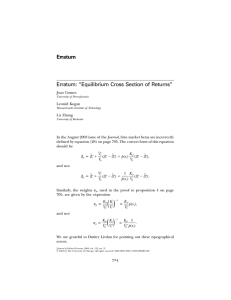
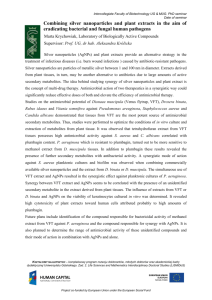

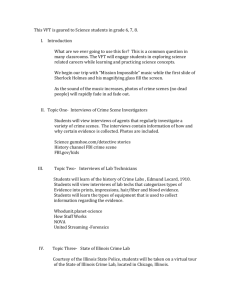
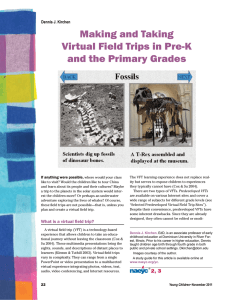
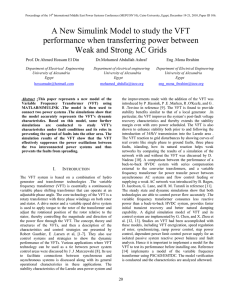
![MA342A (Harmonic Analysis 1) Tutorial sheet 3 [October 29, 2015] Name: Student ID:](http://s2.studylib.net/store/data/010415896_1-9cf3b7b2f94fcd56f13baea47b05fbe2-300x300.png)